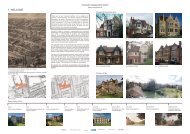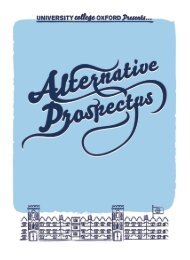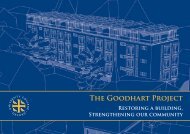North Oxford Development Project
Public consultation boards
Public consultation boards
You also want an ePaper? Increase the reach of your titles
YUMPU automatically turns print PDFs into web optimized ePapers that Google loves.
2.3 HERITAGE ASSETS: THE NORTH OXFORD VICTORIAN GARDEN SUBURB CONSERVATION AREA<br />
1 WELCOME<br />
2<br />
2<br />
<strong>North</strong> <strong>Oxford</strong> <strong>Development</strong> <strong>Project</strong>, University College <strong>Oxford</strong><br />
We are pleased to present University College’s emerging proposals<br />
for the development of its <strong>North</strong> <strong>Oxford</strong> College site. We hope<br />
that you find this exposition informative and the proposed concept<br />
appealing as it celebrates ‘villas and gardens’ in a manner in<br />
<br />
keeping with the Victorian Conservation Area location. We<br />
welcome your comments and feedback.<br />
Public Consultation<br />
<br />
The later, mid to late twentieth-century University structures that,<br />
although not listed, provide diversity in terms of scale, fabric, and use,<br />
thereby contributing to the ‘vibrancy’ of the Conservation Area;<br />
Parts of the garden plots and the varied planting, that both screen and<br />
soften the built forms, provide a generally leafy character perceivable<br />
from mainly Character within the of Site, Conservation but also from a Area limited number of<br />
locations in the immediate surrounding streets via some gaps between<br />
street front properties. The most prominent mature specimen trees<br />
from the nineteenth century form eye-catching landscape features and<br />
contribute positively in architectural, historic and aesthetic terms to<br />
the character and appearance of the conservation area.<br />
The curved Site boundary to the north and the generally irregular Site<br />
outline serves as a reminder of the historic laying out of the centre of<br />
the block; and<br />
University College is shaping a comprehensive and exemplary<br />
development on its <strong>North</strong> <strong>Oxford</strong> site to meet both its pressing and<br />
longer terms needs to accommodate its graduate and undergraduate<br />
members. In so doing, it will help meet the needs of <strong>Oxford</strong> City in<br />
providing adequate college accommodation for its student members.<br />
The development will therefore reduce student pressure on the City’s<br />
more affordable housing stock. The proposal also includes a children’s<br />
nursery for public use, and ancillary student facilities including a gym,<br />
café, academic study spaces and meeting rooms.<br />
<br />
Historic nineteenth-century brick boundary walls and relic garden<br />
buildings form a contrasting form and purpose in comparison to the<br />
lower street front walls seen elsewhere in the conservation area. The<br />
garden buildings and the historic planting (surviving mature trees),<br />
including the relic Edwardian orchards, clearly reflect the ‘garden<br />
suburb’ nature of the Conservation Area. The historical character of<br />
such gardens found within the Site includes productive uses in addition<br />
to an aesthetic amenity value .<br />
The <strong>North</strong> <strong>Oxford</strong> Victorian Suburb Conservation Area is a heritage asset of<br />
moderate (regional) significance, as attested by its statutory designation.<br />
No. 78, Woodstock Road<br />
Plate 5: Reclcliffe Maud House main, southern elevation<br />
No. 28, Staverton Road<br />
Plate 6: 5 Staverton Road main, northern elevation<br />
No. 52, Banbury Road<br />
1<br />
This application builds on an extant planning permission for student<br />
accommodation known as ‘Six Pavilions’ that was secured alongside<br />
the new residential home for Fairfield. While the Fairfield Residential<br />
Home is now complete, the ‘Six Pavilions’ scheme will be set aside in<br />
favour of this proposal, subject to planning permission. The following<br />
display boards illustrate a comprehensive vision for the site.<br />
The vision is for a landscape-led proposal which properly celebrate<br />
the existing mature specimen trees, most notably the two cedars<br />
visible from Banbury Road. New villa buildings are positioned around<br />
a series of lawns and courts. New buildings and the important current<br />
building stock will be sensitively landscaped. The works will include<br />
the reinstatement and enhancement of orchards and new planting of<br />
native trees. The biodiversity of the site will be increased.<br />
1850 Engraving by N. Whittock of the city of <strong>Oxford</strong><br />
We welcome your comments and questions and encourage you<br />
to complete and return the feedback forms by Monday 25th July.<br />
No. 94 Woodstock Road<br />
No. 5, Staverton Road<br />
No. 113, Banbury Road<br />
1. University College <strong>Oxford</strong><br />
2. Woodstock Road and Banbury Road leading to University College <strong>Oxford</strong>, <strong>North</strong> Site<br />
Character of Site<br />
Woodstock Road<br />
Banbury Road<br />
Woodstock Road<br />
Banbury Road<br />
1887 OS Map<br />
1939 OS Map<br />
Fairfield House<br />
View across the site looking south-east from Fairfield House<br />
Recent History of Site<br />
1960s<br />
2015<br />
2016<br />
2017<br />
2018<br />
July 2018<br />
January 2019<br />
July and September 2019<br />
4th Quarter 2019<br />
Philip Dowson Buildings<br />
Fairfield Residential Home & Six<br />
Pavilion Scheme<br />
Acquire Fairfield Villa<br />
Univ’s Architect Competition<br />
Option appraisal over<br />
emerging brief<br />
New Fairfield Residential<br />
Home occupied<br />
Full design team work on<br />
RIBA Stage 2<br />
Public Consultation<br />
Anticipated planning<br />
application submission<br />
Níall McLaughlin Architects
2 SITE ANALYSIS AND CONCEPT<br />
<strong>North</strong> <strong>Oxford</strong> <strong>Development</strong> <strong>Project</strong>, University College <strong>Oxford</strong><br />
Public Consultation<br />
Existing Gardens & Spaces<br />
Existing Trees<br />
Concept<br />
The site has a leafy character, however is<br />
generally is not well defined and as a result is<br />
underused.<br />
The straight brick wall that runs across the south<br />
of the site from Banbury to Woodstock Roads<br />
still marks the transition boundary between farms<br />
and villas.<br />
The view and main approach to Fairfield<br />
Residential Home from Banbury Road is undefined<br />
and compromised by existing Fairfield House<br />
extensions. The setting of Redcliffe-Maud House<br />
is cluttered and unwelcoming.<br />
Access across the site is compromised and<br />
limited by steps.<br />
Fairfield Residential Home Access -<br />
Cluttered approach from Banbury Road<br />
The walnut, mulberry and apple trees across the<br />
site are reminders of when <strong>North</strong> <strong>Oxford</strong> was<br />
covered by orchards and market gardens over a<br />
century ago.<br />
There are a number of large and mature trees,<br />
including significant specimens, such as the<br />
cedar of Lebanon near Banbury Road, a beautiful<br />
copper beech south-west of the Victorian Fairfield<br />
villa and a mulberry tree in front of the Edwardian<br />
Redcliffe - Maud House.<br />
Frontage of Fairfield House - Space feels utilitarian and does not<br />
celebrate the Cedar of Lebanon<br />
The proposal is for the current and new buildings<br />
to frame a series of gardens and courts located<br />
connected by a principal east-west path.<br />
The new buildings define open, south-facing<br />
spaces. The new accommodation blocks are<br />
not linked, but have ‘open corners’ to provide a<br />
generous permeability and appealing view-lines.<br />
All buildings are to be set within garden plots<br />
with varied planting that enhances the built<br />
forms. With retained brick walls, garden buildings<br />
and orchards across the site, the ‘garden<br />
suburb’ nature of the Conservation Area will be<br />
emphasised in both the functional, active spaces<br />
and the areas for quiet reflection.<br />
The pedestrian entrance on Banbury Road is<br />
clearly visible as the main pedestrian entrance.<br />
Students, staff and visitors will typically use this<br />
entrance and the new east to west pedestrian<br />
pathway. It is also accessible from Staverton<br />
Road. In addition, a new cycle path runs along<br />
the line of, and hidden by, the southern wall.<br />
Vehicles enter the site only through controlled<br />
access points of 115A Banbury Road and next<br />
to 25 Staverton Road, and there is not a vehicle<br />
route through the site.<br />
Existing photograph of Redcliffe-Maud House looking East<br />
Mulberry Tree - Opportunity to celebrate champion trees within<br />
the landscape setting<br />
Copper Beech - Opportunity to frame significant landmark trees<br />
Site Constraints and Opportunities for<br />
Improvement and Response<br />
Site Response<br />
New entrance -<br />
more welcoming<br />
increased width<br />
and added trees<br />
These diagrams<br />
illustrate the design<br />
analysis and form<br />
the basis of the<br />
fundamentals of<br />
the development<br />
concept.<br />
1<br />
Staverton<br />
Rd lane is<br />
narrow and<br />
unwelcoming<br />
Rose garden<br />
is isolated and<br />
not well used<br />
Nursery<br />
New framed<br />
entrance square<br />
from Staverton Rd<br />
3<br />
No connection<br />
Area<br />
cluttered and<br />
not well used<br />
2<br />
Garden<br />
to front of<br />
Redcliffe-<br />
Maud to be<br />
celebrated<br />
Garden walls and<br />
planting create<br />
disconnected green<br />
spaces and prevent link<br />
4<br />
Access<br />
compromised<br />
by steps<br />
Blank<br />
elevation<br />
to south<br />
Low quality<br />
extension to<br />
be removed<br />
Garden to rear of<br />
Fairfield House<br />
is undefined and<br />
too open<br />
Copper Beech<br />
tree to be<br />
celebrated<br />
View and main approach<br />
to Fairfield Residential<br />
Home is undefined and<br />
compromised by existing<br />
Fairfield House extensions<br />
Area used for car parking.<br />
Cedar trees are not<br />
celebrated<br />
Low quality extension<br />
to be removed<br />
No connection<br />
through site<br />
New bicycle link<br />
from Woodstock Rd<br />
Framed and<br />
accessible space to<br />
west of Redcliffe-<br />
Maud House<br />
Woodstock<br />
Rd<br />
Villa<br />
Terrace<br />
Villa<br />
New active<br />
lawn to<br />
west of<br />
Greenwood<br />
Buildings<br />
orientated to<br />
minimise north<br />
facing bedrooms<br />
New stepfree<br />
terrace<br />
South facing<br />
garden<br />
Mulberry tree<br />
retained and<br />
celebrated<br />
Rose<br />
garden<br />
integrated<br />
and<br />
accessible<br />
Water<br />
Court<br />
West<br />
Villa<br />
Quiet<br />
Space<br />
Cycle parking<br />
integrated into<br />
landscape<br />
Water<br />
Court<br />
East<br />
Villa<br />
Becomes active and<br />
social heart of new<br />
campus. Framed by new<br />
villas and Fairfield House<br />
Vehicle and service access<br />
integrated<br />
Walnut<br />
Court Villa<br />
Animated by<br />
communal uses<br />
at ground floor<br />
Walnut Lawn<br />
Copper Beech<br />
tree retained<br />
and celebrated<br />
Branbury<br />
Rd<br />
Villa<br />
View and main entrance<br />
approach inproved<br />
Front garden created to<br />
improve setting of Fairfield<br />
House from Banbury Rd<br />
Pedestrian path<br />
through the site<br />
Cedar trees<br />
celebrated<br />
New bicycle entrance<br />
and cycle path<br />
through the site<br />
Níall McLaughlin Architects
Plant<br />
8 sq m<br />
Ablutions<br />
6 sq m<br />
Flexible Playspace<br />
66.9 sq m<br />
Meeting Room<br />
14 sq m<br />
Ablutions<br />
12.6 sq m<br />
GIA<br />
238.9 sq m<br />
Kitchen<br />
5.9 sq m<br />
Office<br />
12.9 sq m<br />
Flexible Playspace<br />
65.6 sq m<br />
GIA<br />
335.5 sq m<br />
GIA<br />
250.4 sq m<br />
Linen Cupboard<br />
1.4 sq m<br />
GIA<br />
333.8 sq m<br />
GIA<br />
28.2 sq m<br />
Quiet Space<br />
28.2 sq m<br />
GIA<br />
333.9 sq m<br />
Linen Cupboard<br />
1.4 sq m<br />
Laundry<br />
2.8 sq m<br />
Ablutions<br />
2.3 sq m<br />
Office<br />
4.7 sq m<br />
Commercial Kitchen<br />
48.6 sq m<br />
Cafe<br />
152.7 sq m<br />
GIA<br />
335.5 sq m<br />
Plant<br />
3 sq m<br />
Cleaning Cupboard<br />
2.6 sq m<br />
Storage<br />
3.3 sq m<br />
Ablutions<br />
16.5 sq m<br />
Bin Store<br />
8.4 sq m<br />
Laundry<br />
7.7 sq m<br />
GIA<br />
248.9 sq m<br />
Storage<br />
0.7 sq m<br />
Linen Cupboard<br />
1.2 sq m<br />
GIA<br />
5.8 sq m<br />
GIA<br />
201.9 sq m<br />
<strong>North</strong> <strong>Oxford</strong> <strong>Development</strong> <strong>Project</strong>, University College <strong>Oxford</strong><br />
3 PROPOSED SITE PLAN<br />
Public Consultation<br />
Approach to the Site<br />
The proposed series of varied and harmonious<br />
garden spaces will complement and enhance<br />
the current mature landscape setting. Buildings<br />
are carefully placed to frame these spaces to<br />
continue the historic concept of ‘arcadian villas<br />
and gardens’.<br />
Staverton Road<br />
M<br />
The scale, materiality and designed form of the<br />
buildings respect their Victorian setting and context,<br />
and aim to create delightful environment in a<br />
garden landscape. They are designed to maximise<br />
sunlight, views and pedestrian connections for the<br />
enjoyment of students, residents, staff and visitors.<br />
Nursery<br />
The scheme comprises:<br />
• The repurposing of the existing Victorian Fairfield<br />
House,<br />
Skirlaw<br />
M<br />
Fairfield<br />
Residential<br />
Home<br />
Linen Cupboard<br />
1.2 sq m<br />
Living / Dining / Kitchen<br />
21.3 sq m<br />
• The removal of the insensitive extensions to<br />
Fairfield House,<br />
Bathroom<br />
6.5 sq m<br />
Laundry<br />
2 sq m<br />
Storage<br />
2.3 sq m Bedroom<br />
Lobby<br />
15.6 sq m<br />
3.3 sq m<br />
Study<br />
6.9 sq m<br />
Lobby<br />
Lobby<br />
Storage<br />
1.1 sq m<br />
2.8 sq m<br />
0.7 sq m<br />
Bathroom<br />
Bedroom / Living / Dining / Kitchen<br />
4.9 sq m<br />
23.5 sq m<br />
• The construction of six new residential buildings,<br />
two ancillary structures and a nursery,<br />
• 150 additional student bedrooms across the<br />
site, and<br />
• A thoughtful and comprehensive landscape that<br />
responds to the inter-generational community<br />
that will use the site.<br />
Proposed New Trees<br />
Woodstock Road<br />
Percy<br />
Bennet<br />
L<br />
Terrace Villa<br />
Storage<br />
3.3 sq m<br />
Changing Room<br />
13.9 sq m<br />
Plant<br />
Bedroom<br />
3 sq m<br />
13.2 sq m<br />
Living / Dining / Kitchen<br />
15 sq m<br />
Cleaning Cupboard<br />
Bathroom<br />
2.6 sq m<br />
3.4 sq m<br />
Gym<br />
120.2 sq m<br />
Lobby<br />
2.9 sq m<br />
Corridor<br />
3.5 sq m<br />
Lobby<br />
4.6 sq m<br />
Storage<br />
2.9 sq m<br />
Laundry<br />
Living / Dining / Kitchen<br />
4.1 sq m<br />
15 sq m<br />
Changing Room<br />
13.9 sq m<br />
Bin Store<br />
Bedroom<br />
7.1 sq m<br />
Bathroom<br />
13.7 sq m<br />
6.4 sq m<br />
Redcliffe -<br />
Maud House<br />
Bedroom<br />
11.8 sq m<br />
Bin Store<br />
7.1 sq m<br />
Common Space<br />
154.8 sq m<br />
Rose Garden<br />
Laundry<br />
4.4 sq m<br />
Storage<br />
3.3 sq m<br />
Living / Dining / Kitchen<br />
15 sq m<br />
Ablutions<br />
10.7 sq m<br />
Bathroom<br />
3.1 sq m<br />
Lobby<br />
2.9 sq m<br />
Corridor<br />
3.5 sq m<br />
Lobby<br />
2.9 sq m<br />
Cleaning Cupboard<br />
Bathroom<br />
2.6 sq m<br />
3.4 sq m<br />
Living / Dining / Kitchen<br />
15 sq m<br />
Bedroom<br />
Plant<br />
13.2 sq m<br />
3 sq m<br />
Student<br />
Gym<br />
G<br />
G<br />
Water Court<br />
F<br />
Ablutions<br />
4.3 sq m<br />
Bin Store<br />
Academic Space<br />
Academic Space<br />
7.1 sq m<br />
13.6 sq m<br />
15.9 sq m<br />
Kitchen<br />
6.2 sq m<br />
Laundry<br />
4.4 sq m<br />
Academic Space<br />
14.1 sq m<br />
Common<br />
Space<br />
Academic Space<br />
15.9 sq m<br />
Cleaning Cupboard<br />
2.6 sq m<br />
Adminstration<br />
33.3 sq m<br />
Living / Dining / Kitchen<br />
36.4 sq m<br />
Storage<br />
3.3 sq m<br />
Academic Space<br />
33.6 sq m<br />
Plant<br />
3 sq m<br />
Lobby<br />
Bathroom<br />
3.4 sq m<br />
3.2 sq m<br />
Bedroom<br />
14.8 sq m<br />
Walnut Lawn<br />
Villa<br />
Student Café<br />
C<br />
C<br />
C<br />
D<br />
Fairfield<br />
House<br />
Banbury Road<br />
A. Cedrus libani (Cedar of Lebanon)<br />
B. Malu spp. (<strong>Oxford</strong> local species apples)<br />
C. Tilia cordata (Small-leaved lime)<br />
D. Malus bramley (Bramley apple)<br />
E. Juglans regia (Walnut)<br />
F. Robinia Frisia (Robinia)<br />
G. Pyrus (Pear)<br />
C<br />
Woodstock<br />
Road Villa<br />
Robinia<br />
Lawn<br />
Greenwood<br />
K<br />
Mulberry<br />
Lawn<br />
K<br />
J<br />
I<br />
Water Court<br />
West Villa<br />
Quiet SpaceI<br />
H H<br />
Water Court<br />
East Villa<br />
E<br />
Walnut Lawn<br />
E<br />
Banbury<br />
Road Villa<br />
B<br />
A<br />
C<br />
H. Luma apiculata (Chilean myrtle)<br />
I. Pinus sylvestris (Scots pine)<br />
J. Fagus s. asplenifolia (Cut-leaf beech)<br />
K. Morus nigra (Mulberry)<br />
L. Zelkova serrata (Zelkova)<br />
M. Fagus sylvatica (Beech)<br />
C’<br />
C<br />
C’<br />
C<br />
N<br />
1:500 @ A1<br />
0 10m<br />
20m<br />
Use Key :<br />
Study bedroom<br />
Single flat<br />
Common use<br />
Academic use<br />
Reception area<br />
Ancillary spaces<br />
Internal circulation<br />
Nursery<br />
Sub-station<br />
Refuse store<br />
Quiet space Student gym<br />
Outline of ‘Six Pavilions’ scheme<br />
Woodstock Road<br />
Woodstock Road House (Existing)<br />
Woodstock Road Villa<br />
Terrace Villa<br />
Greenwood (Existing Building)<br />
Redcliffe-Maud (Existing Building)<br />
Water Court West Villa<br />
Water Court East Villa<br />
Walnut Lawn Villa (In Elevation)<br />
Banbury Road Villa<br />
Banbury Road<br />
Long section CC across the site<br />
Fairfield Residence Home (Behind)<br />
Site Extents<br />
Fairfield House (Behind)<br />
10m 20m 30m<br />
Níall McLaughlin Architects
4 BANBURY ROAD<br />
<strong>North</strong> <strong>Oxford</strong> <strong>Development</strong> <strong>Project</strong>, University College <strong>Oxford</strong><br />
Public Consultation<br />
Boards 4 to 7<br />
The following boards describe the setting and<br />
interior layouts of the accommodation villas. The<br />
narrative starts at Banbury Road frontage and<br />
moves westwards to the Staverton Road access<br />
way.<br />
Generally, active communal use is at ground<br />
floor level and predominantly at the eastern part<br />
of the site. These easternmost villas house a<br />
variety of shared amenities to provide a focus for<br />
community and modest collegial activity.<br />
Banbury Road Villa<br />
A small reception in Banbury Road Villa is the<br />
only adminstration office in the new buildings.<br />
Visitors may take shelter under an outside<br />
canopy and enjoy immediate views of the gardens<br />
beyond. The Banbury Road Villa accommodates<br />
5 academic spaces and student accommodation<br />
on the first and second floors.<br />
Walnut Lawn Villa - Student Café<br />
Refer to View 3 on Board 5<br />
The student café at the northern end of the<br />
walnut tree-lined lawn is designed with informal<br />
seating as well as quiet reading zones. The<br />
cafe’s generous full height glazing allows views<br />
over the terrace and onto the lawn.<br />
Its supporting functions are located on the<br />
northern side for ease of access to the driveway<br />
for deliveries and collection.<br />
A<br />
No. 117<br />
Elevation<br />
1<br />
Student Café<br />
View 1 - Rendered view from Banbury Road of Fairfield House, Walnut L awn Villa and Fairfield Residential Home with new trees lining the boulevard (Existing brick shed shown in outline).<br />
Walnut Lawn<br />
Villa<br />
Porter’s<br />
Lodge &<br />
Reception<br />
Fairfield<br />
House<br />
2<br />
Banbury Road<br />
Walnut Lawn<br />
Banbury<br />
Road Villa<br />
A<br />
3<br />
A<br />
Use Key :<br />
Study bedroom<br />
Common use<br />
Reception area<br />
Internal circulation<br />
Sub-station<br />
No. 113<br />
A’<br />
Single flat<br />
Academic use<br />
Ancillary spaces<br />
Nursery<br />
Refuse store<br />
A<br />
A<br />
Water Court & Walnut Lawn (N.T.S.)<br />
View 2 - Rendered view of the Entrance from Banbury Road showing existing cedars in the foreground and proposed new orchard planting<br />
A’<br />
A’<br />
Banbury Road Elevation<br />
Entrance and Porters’ Lodge<br />
Banbury Road Villa<br />
Site Extents<br />
Fairfield House (Existing Building)<br />
Section A-A’<br />
1:500<br />
10m 20m 30m<br />
10m<br />
20m<br />
30m<br />
Site Section AA<br />
Walnut Lawn Villa<br />
Banbury Road Villa<br />
Fairfield House (In Elevation) Porters’Lodge and Entrance<br />
Site Extents<br />
Section A-A’<br />
1:500<br />
Garden to Rawlinson Road House<br />
10m 20m 30m<br />
10m<br />
20m<br />
30m<br />
Rawlinson Road H<br />
B<br />
B<br />
Níall McLaughlin Architects<br />
B’<br />
B’
5 WALNUT LAWN<br />
<strong>North</strong> <strong>Oxford</strong> <strong>Development</strong> <strong>Project</strong>, University College <strong>Oxford</strong><br />
Public Consultation<br />
View 3 - Rendered view of Walnut Lawn, looking <strong>North</strong> towards the student café (Refer to Board 4 for location)<br />
Níall McLaughlin Architects
Shelves<br />
1<br />
2<br />
3<br />
4<br />
5<br />
6<br />
7<br />
8<br />
9<br />
10<br />
11<br />
12<br />
Wheelchair<br />
Parking<br />
Shelves<br />
Wardrobe<br />
Riser Riser Above<br />
Riser Riser<br />
Riser Riser<br />
Riser<br />
Riser<br />
Riser Above<br />
Riser<br />
Riser<br />
Riser<br />
Cleaning<br />
Cupboard<br />
Shelves<br />
24 Risers @ 156.25mm<br />
12<br />
1<br />
10<br />
8<br />
9<br />
1<br />
2<br />
3<br />
4<br />
5<br />
6<br />
7<br />
Riser<br />
Shelves<br />
Wardrobe<br />
6 WATER COURT<br />
Benefits of the Proposal vs. the ‘Six Pavilions’ Scheme<br />
<strong>North</strong> <strong>Oxford</strong> <strong>Development</strong> <strong>Project</strong>, University College <strong>Oxford</strong><br />
Public Consultation<br />
Southern Elevation of Fairfield Residential Home<br />
• The Water Court Villas occupy a broadly<br />
similar footprint to the permitted ‘Six Pavilions’<br />
scheme, but allow for more space, permeability<br />
and an improved aspect.<br />
• Distance from the southern boundary has<br />
been increased to conserve existing trees to<br />
the south of the site.<br />
• The two new residential buildings are spaced<br />
more widely than the previous ‘Six Pavilions’<br />
scheme which allows space for a simple paved<br />
forecourt with a reflecting rill and benches.<br />
This will create an entrance and outside space<br />
for the accommodation buildings.<br />
• The Quiet Space, a stand-alone pavilion to<br />
the south of the Water Court, may be used for<br />
quiet study.<br />
• The scheme has no new basements, which will<br />
reduce construction programme and impact.<br />
The College is exploring with the trustees of Fairfield Residential Home the merits<br />
of espalier pear planting on the southern walls of the home and possible the<br />
installation of balconies on the first and second floor for the amenity of its residents.<br />
Fairfield Residential Home<br />
Rose Garden<br />
Balcony to the South of<br />
Fairfield Residential Home<br />
Water Court West Villa<br />
Water Court East Villa<br />
Riser<br />
Riser<br />
Riser<br />
Riser<br />
AHU<br />
Workout benches<br />
Rowing Machine<br />
Trendmills<br />
Gym<br />
Gym<br />
116 sq m<br />
Riser Above<br />
Riser Above<br />
Multi-exercise centres<br />
Yoga Mats<br />
AHU (TBC) Riser Riser<br />
Common Space<br />
Common Space<br />
146.3 sq m<br />
Ablutions<br />
13.7 sq m<br />
Ablutions<br />
13.7 sq m<br />
Chair Store<br />
Table Store<br />
Riser<br />
Bin Store<br />
3.4 sq m<br />
Laundry<br />
4.4 sq m<br />
Lift Shaft<br />
1600 x 1750<br />
Linen<br />
Cupboard<br />
Storage<br />
6.8 sq m<br />
Living / Dining / Kitchen<br />
13.9 sq m<br />
Bathroom<br />
6 sq m<br />
Living / Dining / Kitchen<br />
13.9 sq m<br />
Bedroom<br />
12.8 sq m<br />
Corridor<br />
8 sq m<br />
Bathroom<br />
2.3 sq m<br />
Bedroom<br />
10.6 sq m<br />
Riser<br />
Riser<br />
Riser<br />
Riser<br />
Riser<br />
Lift Shaft<br />
1600 x 1750<br />
Shelves<br />
Cleaning<br />
Cupboard<br />
Laundry<br />
4.4 sq m<br />
Bin Store<br />
3.4 sq m<br />
Water Court<br />
Walnut Lawn<br />
Linen<br />
Cupboard<br />
24 Risers @ 156.25mm<br />
Riser<br />
Riser Riser<br />
Storage<br />
6.8 sq m<br />
Living / Dining / Kitchen<br />
13.9 sq m<br />
Bathroom<br />
6 sq m<br />
Living / Dining / Kitchen<br />
13.9 sq m<br />
Bedroom<br />
11.2 sq m<br />
Bathroom<br />
2.3 sq m<br />
Corridor<br />
8.3 sq m<br />
Wardrobe<br />
Bedroom<br />
12.6 sq m<br />
4<br />
Wardrobe<br />
Quiet<br />
Quiet 28.2 sq m<br />
Space<br />
Water Court Plan (N.T.S.)<br />
View 4 - Rendered view of Water Court, looking <strong>North</strong> towards Fairfield Residential Home. Proposed balcony and pear trees added to Fairfield Residential Home<br />
Use Key:<br />
Residential<br />
Common use<br />
Quiet space<br />
Ancillary spaces<br />
Student gym<br />
Internal circulation<br />
Outline of ‘Six Pavilions’ scheme<br />
Níall McLaughlin Architects
<strong>North</strong> <strong>Oxford</strong> <strong>Development</strong> <strong>Project</strong>, University College <strong>Oxford</strong><br />
7 WOODSTOCK AND STAVERTON ROAD<br />
Public Consultation<br />
At the western end of the site there are two student accommodation<br />
buildings and a nursery. The accommodation buildings have limited<br />
visibility from Woodstock Road as per Views 6 and 7.<br />
Following consultation with <strong>Oxford</strong> City Council, these views have been<br />
produced to illustrate the proposals as seen from Woodstock Road. They<br />
convey that, when viewed through the trees of Woodstock Road gardens, the<br />
proposed buildings are seen only partially.<br />
Staverton Road<br />
8<br />
No. 21<br />
No. 19<br />
No. 23<br />
No. 25<br />
No. 104<br />
Nursery<br />
Skirlaw<br />
Fairfield Residential<br />
Home Car Park<br />
Percy<br />
Bennet<br />
Terrace Villa<br />
9<br />
View 5 - Staff, students and visitors route, looking East towards Water Court West Villa<br />
Redcliffe -<br />
Maud House<br />
Woodstock Road<br />
No. 100<br />
5<br />
Woodstock<br />
Road Villa<br />
6<br />
No. 98<br />
Robinia<br />
Lawn<br />
Mulberry<br />
Lawn<br />
No. 96<br />
Greenwood<br />
7<br />
No. 94<br />
Ground floor plan of the Banbury Road Villa and Fairfield House (N.T.S.)<br />
View 6 - Current proposal of Woodstock Road Villa as seen from Woodstock Rd between no. 98 & 96<br />
View 7 - Current proposal of Woodstock Rd Villa as seen from Woodstock Rd between no. 96 & 94<br />
Use Key:<br />
Residential<br />
Common use<br />
Quiet space<br />
Ancillary spaces<br />
Student Gym<br />
Internal circulation<br />
Níall McLaughlin Architects
8 COMMUNITY OPPORTUNITIES<br />
<strong>North</strong> <strong>Oxford</strong> <strong>Development</strong> <strong>Project</strong>, University College <strong>Oxford</strong><br />
Public Consultation<br />
A<br />
Staverton Road Nursery<br />
B<br />
The Orchard & Garden Spaces<br />
The nursery is located in the north-western corner of the site at the Staverton Road<br />
entrance. The building is a single storey structure that follows the design guidance for<br />
premises to house a nursery, available to the public, with up to 50 places.<br />
Heritage orchards, along with those shared with the residents of the new Fairfield<br />
Residential Home will be maintained and sensitively enhanced. The aspiration is that<br />
these resources will provide an attractive amenity for the inter-generational community.<br />
View 8 - Rendered view of the nursery from Staverton Road (View labelled on Board 7)<br />
The Orchard north of Fairfield Residential Home<br />
F<br />
New Landscaping to the West of Redcliffe-Maud House<br />
C<br />
Student Café<br />
Changes are proposed to enhance inclusive access for the those with restricted mobility.<br />
The levels of the paths will be regularised, and the southfacing terrace of Redcliffe-Maud<br />
House extended. Additional mulberry tree planting is proposed for the lawn.<br />
The student café is designed with informal seating as well as quiet reading zones.<br />
The cafe’s generous full height glazing encourages views over the terrace and onto<br />
the tree-lined lawn down to the specimen copper beech.<br />
PLACEMAKING FOR AN<br />
INTERGENERATIONAL<br />
COMMUNITY<br />
View 9 - Rendered view of Redcliffe-Maud House & Greenwood looking East with Water Court West Villa beyond<br />
(View labelled on Board 7)<br />
The student café with external seating alongside of the pedestrian path, overlooking Walnut Lawn<br />
E<br />
The Rose Garden<br />
D<br />
Balcony to the South of Fairfield Residential Home<br />
This vital space to the east of Redcliffe-Maud House is already greatly appreciated by<br />
the residents of Fairfield Residential Home and will be preserved.<br />
View from Fairfield Residential Home looking south to Water Court. Landscaping and<br />
planting enhance the views out from the Residential Home. The potential for a balcony<br />
would provide further opportunities for residents to enjoy the gardens.<br />
Rose Garden with bluebells in the early spring<br />
Residents of Fairfield Residential Home with local students<br />
Níall McLaughlin Architects
9 BUILDING DESIGN AND SUSTAINABILITY<br />
<strong>North</strong> <strong>Oxford</strong> <strong>Development</strong> <strong>Project</strong>, University College <strong>Oxford</strong><br />
Public Consultation<br />
Façade Design<br />
Proposed Sustainability Strategy<br />
The form and façade strategy for the<br />
accommodation buildings aims to develop a<br />
confident architectural scale and language that<br />
unifies the new buildings as a coherent ensemble<br />
that responds directly to the existing character of<br />
the surrounding Conservation Area.<br />
The emerging design utilises architectural design<br />
elements from the local vernacular to provide<br />
simple and recognisable references, including<br />
pitched roofs, gabled elevations, use of vertical<br />
elements, carefully detailed and articulated<br />
window openings, and interiors with a distinct<br />
relationship to the garden spaces.<br />
3<br />
2<br />
The proposals target a 40% reduction in carbon<br />
emissions by employing a multifaceted approach,<br />
including:<br />
• Fabric first design with high levels of insulation<br />
• High quality windows with generous openings<br />
for good natural light and ventilation<br />
• Glazing areas considered to avoid overheating<br />
• Low carbon technology including:<br />
• Air source heat pump for hot water<br />
• Use of heat recovery ventilation for fresh air<br />
All of this is to be achieved with sustainability at<br />
the fore.<br />
The key features in the façade strategy are:<br />
4<br />
1. The study bedroom windows are simple pairs<br />
of fixed and opening side-hung casements.<br />
The glazing is generous to provide the required<br />
daylight and free area for ventilation.<br />
1<br />
2. The top floor windows follow the roof line,<br />
clearly expressing these rooms as ‘attic<br />
spaces’.<br />
3. Clay tiles are proposed as the roof finish to sit<br />
well within the existing Victorian context.<br />
4. The strategy and materials are clearly<br />
contemporary while allowing variation to occur<br />
through location and type of windows. For<br />
example, we imagine that the fenestration<br />
to the kitchen / dining areas will be more<br />
generous and projecting.<br />
Structural Frame - CLT<br />
Cross laminated timber or ‘CLT’ is a method of<br />
sustainable construction that uses timber for the<br />
structure instead of higher carbon concrete or<br />
steel.<br />
Structural walls, floors and roofs are built in<br />
panels and assembled on site - meaning faster<br />
construction. An approximate 90% reduction<br />
in deliveries to site in the first 6-9 months of<br />
construction reduce<br />
Approximately 90% reduced deliveries to site for<br />
the first 6-9 months of construction and reduced<br />
overall construction period.<br />
Aerial view of East façade of Water Court West Villa<br />
Catherine Hughes <strong>Project</strong>, Somerville College by NMLA<br />
UNIV-NORTH - ENERGY STRATEGY<br />
Legislative context<br />
0.6<br />
The sustainability and energy targets of a building Our approach can be defined in<br />
0.2<br />
The aim of the environmental and energy strategy is to produce a<br />
various ways.<br />
An energy strategy that leads to low energy consumption with simple<br />
building which is:<br />
Section diagram showing mechanical and electrical plant strategy leads to of low a typical running building costs and more robust carbon reductions.<br />
Part L of the Building Regulations says that a new building’s annual<br />
0.1<br />
carbon emissions must be less than the emissions of the building as<br />
comfortable (the right temperature, sufficient ventilation, no glare, 0.5<br />
calculated Electricity with Grid an accredited - Part L calculation. The main energy demands in student residential buildings are generally<br />
good acoustics);<br />
Current <strong>Project</strong>ed <strong>Oxford</strong> planning policy says that space there should heating be and a 10% domestic hot water. Space heating demands can be<br />
attractive (bright, airy);<br />
reduction in carbon emissions over the Part reduced L baseline, through with this passive architectural<br />
0<br />
design whereas domestic hot<br />
easy to use (giving people simple intuitive control of their<br />
reduction being provided by on-site renewable energy generation<br />
0.4<br />
2010 2020 2030 2040 2050<br />
technology<br />
water demands can only really be reduced by focussing on the supply of<br />
environment);<br />
UNIV-NORTH UNIV-NORTH - ENERGY STRATEGY<br />
Future <strong>Oxford</strong> planning policy says that a new building should<br />
low energy - ENERGY STRATEGY<br />
energy.<br />
achieve a 40% reduction in carbon emissions over the Part L<br />
and low carbon<br />
baseline and also achieve a BREEAM rating of “Excellent”<br />
0.6<br />
Our approach<br />
0.6 0.3<br />
Our In our approach view, a sensible energy strategy should aim to:<br />
The aim of the environmental and energy strategy is to produce a<br />
An energy 100%<br />
The aim of the environmental and energy strategy is to produce a<br />
strategy that leads to low energy consumption An energy strategy that leads to low energy consumption with simple Catering with simple<br />
building which is:<br />
Carbon context<br />
building which is:<br />
plant leads to low running costs and more robust carbon reductions.<br />
The carbon intensity of grid electricity is changing plant all leads <br />
the time to maintain low as new running comfortable costs and conditions more robust passively carbon for reductions. much of the<br />
Other<br />
Legislative context<br />
90%<br />
comfortable (the right temperature, sufficient ventilation, no glare, 0.5<br />
renewable capacity brought on line and older, coal fired generation year<br />
The sustainability and energy targets of a building can be defined in<br />
0.5 0.2<br />
Gas emissions<br />
is<br />
Space heating heating<br />
comfortable (the right temperature, sufficient ventilation, no glare,<br />
Electricity Grid -<br />
The main energy demands in student residential buildings are generally<br />
decommissioned. Electricity<br />
various ways.<br />
good acoustics);<br />
Grid Grid - - <strong>Project</strong>ed The main energy reduce demands space heating student demand residential passively buildings as far are as practical generally<br />
good acoustics);<br />
<strong>Project</strong>ed<br />
space 80% heating and domestic hot water. Space heating DHW use use<br />
<strong>Project</strong>ed<br />
demands can be<br />
attractive (bright, airy);<br />
space heating focus and electrically domestic hot driven water. plant Space on the heating remaining demands heatcan be<br />
attractive (bright, airy);<br />
40.0<br />
We think that the energy strategy for the building should be considered reduced through passive architectural design whereas domestic hot<br />
Part L of the Building Regulations easy to use says (giving that a people new building’s simple intuitive annual control of their<br />
reduced through demands passive architectural design whereas domestic hot<br />
easy to use (giving people simple intuitive control of their<br />
0.4<br />
against realistic carbon criteria to achieve the best performance. This<br />
70%<br />
water demands can only really be reduced by focussing on the supply of<br />
environment);<br />
0.4 0.1<br />
carbon emissions must be less than the emissions of the building as<br />
water demands can only really be reduced by focussing on the supply of<br />
environment);<br />
means that using electricity locally is less carbon intensive while the<br />
35.0<br />
low energy<br />
energy.<br />
low calculated energywith an accredited Part L calculation.<br />
“displacement” benefits of generating electricity energy. Preliminary<br />
locally are<br />
calculations<br />
smaller.<br />
suggest that the annual carbon emissions Difficult<br />
60%<br />
Difficult to<br />
to<br />
affect<br />
affect<br />
<br />
and Current low <strong>Oxford</strong> carbonplanning policy and low says carbon that there should be a 10%<br />
associated with such a strategy are >40% lower than a gas-fired Part-L these through 30.0<br />
reduction in carbon emissions over the Part L baseline, with this<br />
0<br />
0.3<br />
Strategies that move energy consumption from gas to electricity is a In our view, a sensible energy strategy should aim to:<br />
0.3<br />
In compliant our view, baseline a sensible scheme. energy strategy should aim to:<br />
50%<br />
building design<br />
reduction being provided by on-site renewable energy generation<br />
2010 2020 2030 good long 2040 term strategy. Not 2050 only is the fuel’s carbon content ever<br />
25.0<br />
technology<br />
decreasing, but eliminating local fossil fuel emissions completely is<br />
maintain comfortable conditions passively for much of the<br />
Legislative context<br />
The exact carbon maintain emissions comfortable would<br />
40%<br />
conditions depend passively the detailed much design of of the the<br />
Legislative Future context <strong>Oxford</strong> planning policy says that a new building should<br />
better for local air quality.<br />
year<br />
Space heating heating 20.0<br />
The sustainability and energy targets of a building can be defined in<br />
0.2<br />
buildings and year the modelling methodology chosen.<br />
The sustainability achieve a 40% and reduction energy targets in carbon of emissions a building over can be the defined Part L in<br />
0.2<br />
reduce space heating demand and passively domestic as hot far as hot practical<br />
various ways.<br />
reduce space heating 30% demand passively as far as practical<br />
various baseline ways. and also achieve a BREEAM rating of “Excellent”<br />
–<br />
15.0<br />
focus electrically driven plant on water the remaining dominate heat -<br />
focus electrically driven plant on the remaining heat it sense to<br />
Part L of the Building Regulations says that a new 100% building’s annual<br />
Catering<br />
20%<br />
demands<br />
it makes sense to<br />
focus any energy<br />
Part L of the Building Regulations says that a new building’s annual<br />
demands<br />
10.0<br />
Carbon context<br />
0.1<br />
carbon emissions must be less than the emissions 0.1 of the building as<br />
focus strategy any on these energy<br />
carbon emissions must be less than the emissions of the building as<br />
Other<br />
The carbon intensity of grid electricity calculated is changing with accredited all the time Part as L new calculation.<br />
Preliminary<br />
10%<br />
calculations suggest that the annual carbon emissions<br />
calculated with an accredited Part L calculation.<br />
90%<br />
Preliminary calculations suggest that the annual carbon emissions strategy these 5.0<br />
renewable Current capacity <strong>Oxford</strong> is planning brought policy Current on line says and <strong>Oxford</strong> that older, there planning coal should fired policy generation be says a 10% that is there should be a 10%<br />
Space heating<br />
associated with such a strategy associated are >40% with such lower a than strategy a gas-fired are >40% Part-L lower than a gas-fired Part-L<br />
decommissioned.<br />
reduction in carbon emissions reduction over in the carbon Part L emissions baseline, with over this the Part L baseline, with this<br />
0<br />
Indicative annual compliant 0% carbon baseline emissions scheme.<br />
0.0<br />
reduction being provided by on-site renewable energy 80%<br />
0<br />
compliant baseline scheme.<br />
generation<br />
2010 2020<br />
DHW use<br />
reduction being provided by on-site renewable energy generation<br />
2010 2020 2030 2040 2030 2050 2040 2050<br />
1<br />
technology<br />
40.0<br />
We think technology that the energy strategy for the building should be considered<br />
The exact carbon emissions The would exact depend carbon emissions the detailed would design depend of on the the detailed design of the<br />
against Future realistic <strong>Oxford</strong> carbon planning criteria<br />
policy Future<br />
to achieve says <strong>Oxford</strong> that the a planning<br />
best new performance. building policy should says that<br />
This<br />
a new building 70% should<br />
buildings and the modelling buildings methodology and the chosen. modelling methodology chosen.<br />
achieve a 40% reduction in carbon emissions over the Part L<br />
means achieve that using a 40% electricity reduction locally in carbon is less emissions carbon intensive over the while Part Lthe<br />
35.0<br />
baseline and also achieve a BREEAM rating of “Excellent”<br />
“displacement” baseline and benefits also achieve of generating a BREEAM electricity rating of locally “Excellent” are smaller.<br />
60%<br />
Difficult to affect<br />
>40%<br />
Max Fordham LLP is a Limited Liability Partnership Registered office<br />
Catherine Hughes <strong>Project</strong>, Somerville College by NMLA Balliol College Student Accommodation by NMLA<br />
100% CO2 100% Equivalent emissions Registered these in Catering<br />
England of electricity and through<br />
Wales Number OC300026 and gas 42–43 Gloucester Catering 30.0Crescent, London, NW1 7PE Energy usage in student accommodation<br />
reduction in<br />
Carbon Strategies context that move energy Carbon consumption context from gas to electricity is a<br />
building design<br />
50%<br />
Other<br />
emissions<br />
The good carbon long term intensity strategy. of grid The Not electricity carbon only is the intensity is fuel’s changing of carbon grid all the electricity content time as ever is new changing all the time as new<br />
Other<br />
90%<br />
90%<br />
25.0<br />
renewable decreasing, capacity but eliminating is brought renewable local on fossil line capacity and fuel older, emissions brought coal fired completely on generation line and is older, is coal fired generation is<br />
Space heating<br />
Space heating<br />
decommissioned.<br />
40%<br />
Níall McLaughlin Architects<br />
decommissioned.<br />
better for local air quality.<br />
80%<br />
Space heating<br />
Indicative annual carbon emissions<br />
DHW<br />
20.0<br />
80%<br />
use Indicative annual carbon emissions<br />
DHW use<br />
and domestic hot<br />
40.0<br />
We think that the energy strategy for the building should 30% be considered<br />
40.0<br />
We think that the energy strategy for the building should be considered<br />
water dominate –<br />
15.0<br />
against realistic carbon criteria to achieve the best performance. This<br />
70%<br />
against realistic carbon criteria to achieve the best performance. This<br />
70%<br />
it makes sense to<br />
means that using electricity locally is less carbon intensive while the<br />
35.0<br />
35.0<br />
CO 2 Equivalent Emissions (kgCO 2e 2 Equivalent /kWh) Emissions (kgCO 2e /kWh)<br />
CO2 Equivalent Emissions (kgCO2ₑ / kWh)<br />
CO 2 Equivalent Emissions (kgCO 2e /kWh)<br />
UNIV-NORTH - ENERGY STRATEGY<br />
The aim of the environmental and energy strategy is to produce a<br />
building which is:<br />
<br />
<br />
<br />
<br />
<br />
comfortable (the right temperature, sufficient ventilation, no glare,<br />
good acoustics);<br />
attractive (bright, airy);<br />
easy to use (giving people simple intuitive control of their<br />
environment);<br />
low energy<br />
and low carbon<br />
l .yr) carbon emissions (kgCO 2 /m 2 .yr)<br />
2 .yr)<br />
Percentage of Energy Use<br />
CO 2 Equivalent Emissions (kgCO 2e /kWh)<br />
0.6<br />
0.5<br />
0.4<br />
0.3<br />
Electricity Grid -<br />
<strong>Project</strong>ed<br />
Annual carbon emissions (kgCO 2 /m 2 .yr)<br />
Our approach<br />
An energy strategy that lead<br />
plant leads to low running c<br />
The main energy demands i<br />
space heating and domestic<br />
reduced through passive arc<br />
water demands can only rea<br />
energy.<br />
In our view, a sensible energ<br />
<br />
<br />
<br />
maintain comfo<br />
year<br />
reduce space he<br />
focus electricall<br />
demands<br />
Preliminary calculations sug<br />
associated with such a strat<br />
compliant baseline scheme.<br />
The exact carbon emissions<br />
buildings and the modelling<br />
Indicative an<br />
Baseline gas-fired Part-L<br />
compliant scheme
10 NEXT STEPS<br />
<strong>North</strong> <strong>Oxford</strong> <strong>Development</strong> <strong>Project</strong>, University College <strong>Oxford</strong><br />
Public Consultation<br />
Indicative Programme<br />
July 2019<br />
September 2019<br />
4th Quarter 2019<br />
2nd Quarter 2020<br />
4th Quarter 2020<br />
3rd Quarter 2023<br />
First Public Consultation<br />
Second Public Consultation<br />
Submission of Planning<br />
Application<br />
Anticipated OCC Determination<br />
of Planning Application<br />
Start on Site<br />
(Subject to Planning)<br />
Target Occupation<br />
<strong>Project</strong> Delivery Commitments<br />
• The college will appoint a contractor who is a member<br />
of the considerate constructor scheme.<br />
• The design will include prefabricated elements such<br />
as the cross laminated timber frame. This will reduce<br />
the number of deliveries (and therefore disruption by<br />
circa. 80% in the first 6-months of the project).<br />
• The contractor will be required to locate a traffic<br />
marshal on Banbury Road for the duration of the works<br />
to safely manage vehicles accessing and egressing<br />
site.<br />
• A construction traffic management plan will be agreed<br />
with the County Council well in advance of the works<br />
and will endeavour to:<br />
- Reduce deliveries outside of peak traffic hours in<br />
the morning and afternoon.<br />
- Exclude contractor parking on-site.<br />
- Monitor noise throughout the construction period.<br />
• Issue a monthly newsletter to all local neighbours<br />
updating on progress and forthcoming works.<br />
Photograph of the physical site model (1:250)<br />
Níall McLaughlin Architects
















